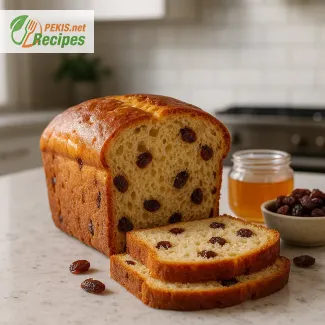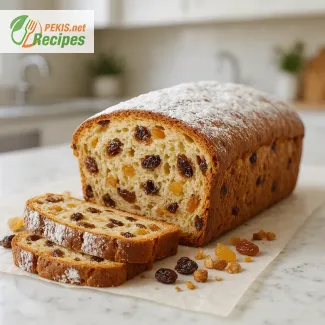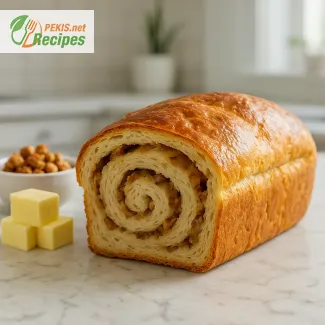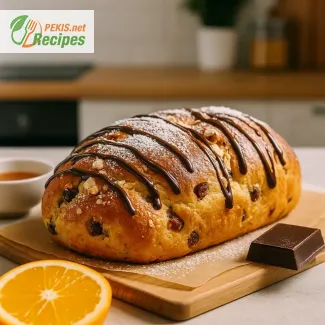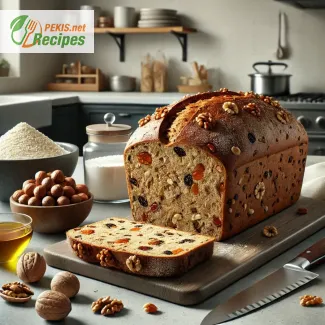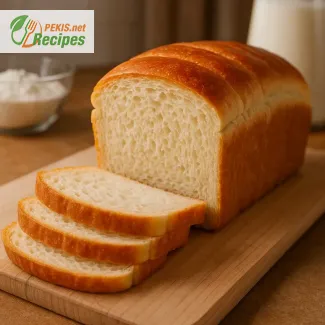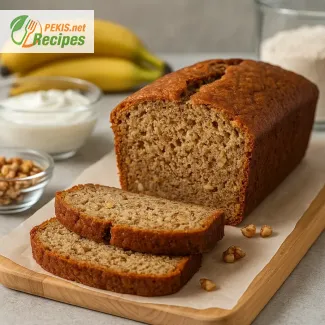
A guilt-free delight: banana bread made without sugar but full of flavor
Discover the naturally sweet comfort of sugar-free banana bread
There’s something undeniably comforting about the warm aroma of freshly baked banana bread wafting through the kitchen. For many, it's a nostalgic reminder of childhood breakfasts or cozy weekend brunches. But in today’s health-conscious world, traditional recipes laden with sugar don’t always fit into our balanced lifestyle. That’s where healthy sugar-free banana bread steps in – a recipe that preserves all the rich, tender goodness of the original while replacing refined sugars with naturally sweet ingredients that nourish the body and please the palate.
This sugar-free banana bread is not just another version of the classic; it’s a thoughtfully crafted recipe designed for those who value clean eating without sacrificing taste. Whether you're following a low-sugar diet, managing your blood sugar, or simply looking for a better way to enjoy your favorite baked goods, this banana bread is a wholesome solution that fits into any routine. Thanks to the natural sweetness of ripe bananas, every slice is moist, aromatic, and deeply satisfying—without the crash that often follows sugary treats.
Why sugar-free banana bread is the perfect healthy breakfast or snack
Choosing no added sugar doesn’t mean choosing less flavor. In fact, ripe bananas, when perfectly mashed and combined with complementary ingredients like cinnamon, vanilla, and nuts, bring out a complexity and richness that often gets overshadowed by excessive sweeteners in traditional recipes. This bread shines as a healthy breakfast option, especially for busy mornings when you need something quick, energizing, and delicious. It’s also an ideal snack between meals, offering a naturally sweet bite that feels indulgent yet wholesome.
Moreover, this banana bread without sugar pairs beautifully with other nutritious elements. Spread it with a thin layer of almond butter or Greek yogurt for added protein, or enjoy it alongside a hot cup of herbal tea for a peaceful afternoon break. For parents looking to introduce better snacking habits, this bread can easily become a lunchbox favorite. Its soft texture and mild, fruity sweetness are especially appealing to children—without any of the artificial flavors or hidden sugars common in store-bought baked goods.
The power of natural ingredients in sugar-free baking
The secret to creating a satisfying sugar-free banana bread lies in harnessing the natural sugars found in bananas and choosing ingredients that offer more than just sweetness. By using overripe bananas, which are rich in natural fructose, the bread develops a deep, caramel-like flavor profile. Enhancing this with a touch of pure vanilla extract, warm spices like cinnamon or nutmeg, and perhaps a handful of chopped walnuts or dark chocolate chips (sweetened with stevia or not at all), results in a loaf that’s not only flavorful but also satisfying and complex.
Instead of white flour, you can even opt for whole wheat or gluten-free flours to boost the bread’s nutritional value. Meanwhile, healthy fats like coconut oil or extra virgin olive oil add richness and moisture without weighing the loaf down. These smart swaps make the banana bread not just a sugar-free treat, but a celebration of nutrient-dense ingredients that support wellness and longevity.
Common mistakes and how to avoid them when baking sugar-free banana bread
One of the most frequent missteps in baking without sugar is relying too heavily on sugar substitutes that don’t behave like real sugar. They can lead to dense or rubbery textures and often impart an undesirable aftertaste. This recipe avoids that entirely by relying on whole food ingredients—especially bananas at their ripest stage, which contribute both moisture and natural sweetness.
Another common error is overmixing the batter. When flour is stirred too vigorously, gluten develops, making the bread tough instead of soft and tender. To achieve the best texture, gently fold the ingredients just until combined. Using the right size loaf pan and monitoring the baking time also ensures a uniform crumb and prevents dryness or underbaking. Keeping these small details in mind will help you consistently produce a banana bread that feels every bit like a comforting indulgence, even without the sugar.
Why homemade sugar-free banana bread beats store-bought alternatives
While grocery store shelves are increasingly lined with products labeled as “sugar-free,” many still contain hidden artificial sweeteners, preservatives, or ingredients that don’t align with a whole-food lifestyle. Baking your own banana bread at home gives you full control over what goes into your food. It also allows you to tailor the loaf to your preferences—maybe you love adding chopped pecans, a hint of ginger, or even a swirl of unsweetened cocoa for richness.
Plus, homemade banana bread is fresher, more fragrant, and infinitely more customizable than any pre-packaged alternative. You can cut thick, generous slices or thin, dainty ones depending on your appetite or occasion. You can bake it ahead and freeze individual portions for busy weeks or enjoy it warm out of the oven with family on a cozy morning.
In addition, baking banana bread can be a soothing ritual, a way to connect with wholesome ingredients and share a slice of care with others. Its simplicity invites creativity, while its familiar texture and flavor bring comfort and joy to every bite.
Healthier variations and ingredient substitutions for dietary needs
For those with specific dietary goals or restrictions, this banana bread is incredibly versatile. You can easily make it gluten-free by using almond flour, oat flour, or a blend of gluten-free baking flours. For a vegan version, swap out eggs for flaxseed or chia seed “eggs” and use plant-based milk alternatives like almond or oat milk.
If you're looking to reduce carbohydrates further, incorporate coconut flour and cut back on the banana slightly, enhancing flavor with low-carb ingredients like unsweetened shredded coconut or seeds. Each of these changes brings a new dimension to the bread, letting you adapt the recipe to your evolving health goals without losing the core essence of what makes banana bread beloved in the first place.
By focusing on ingredients that are naturally sweet, full of fiber, and rich in nutrients, you can enjoy a banana bread experience that feels good in every sense. Whether it's a morning boost, a midday bite, or an after-dinner treat, sugar-free banana bread delivers on both comfort and care.
- Preheat the oven to 175°C (350°F). Line a standard 23 x 13 cm (9 x 5 inch) loaf pan with parchment paper or lightly grease it with a bit of olive oil.
- In a large mixing bowl, mash the ripe bananas with a fork or potato masher until smooth.
- Add the eggs, Greek yogurt, olive oil, and vanilla extract to the mashed bananas. Whisk until the mixture is well combined and creamy.
- In a separate bowl, mix the whole wheat flour, baking soda, cinnamon, and salt.
- Gradually fold the dry ingredients into the banana mixture using a spatula or wooden spoon. Stir just until no streaks of flour remain – do not overmix.
- If using, fold in the chopped walnuts.
- Pour the batter into the prepared loaf pan and smooth the top with a spatula.
- Bake in the preheated oven for 45–50 minutes, or until a toothpick inserted in the center comes out clean.
- Let the banana bread cool in the pan for 10 minutes, then transfer it to a wire rack to cool completely.
- Slice and serve plain, or with a spread like nut butter or natural yogurt.
Transforming banana bread into a nourishing delight without added sugar
Enhancing flavor, texture, and nutrition with natural ingredients and smart techniques
Sugar-free banana bread is already a wonderful alternative to traditional versions filled with refined sugars, but with a few carefully chosen adjustments, this wholesome recipe can become even more flavorful, more satisfying, and better tailored to your dietary preferences. Understanding how each ingredient contributes to texture, taste, and nutrition allows you to customize the loaf to suit your goals—whether that’s reducing carbohydrates, increasing protein, or simply enjoying a new layer of flavor complexity.
How ingredient swaps can elevate your banana bread
One of the easiest ways to improve banana bread without sugar is by selecting the ripest bananas possible. Bananas with brown spots on the skin are ideal because they contain more natural sugars like fructose, which enhance sweetness without adding refined sugar. If you're looking to create even more depth in flavor, you can roast the bananas before mashing them. This caramelizes their sugars, adding a rich, almost toffee-like note to the loaf.
For a boost in fiber and nutrients, replace half of the whole wheat flour with almond flour or oat flour. Almond flour introduces a slightly nutty aroma and helps to keep the crumb moist, while oat flour makes the bread softer and enhances its earthy, wholesome quality. These flours also contribute healthy fats and additional fiber, making each slice more filling and beneficial for digestive health.
If you enjoy a denser, chewier loaf, consider adding chia seeds or ground flaxseeds to the batter. Not only do they absorb moisture and bind ingredients together, but they’re also rich in omega-3 fatty acids and plant-based protein, which contribute to heart and brain health.
Homemade versus store-bought: flavor and freshness win every time
It’s easy to underestimate how much better homemade banana bread can be. When made fresh, it’s warm, aromatic, and tailored exactly to your taste. Store-bought versions, even those labeled as “healthy,” often contain preservatives, added sugars, or stabilizers that dilute the flavor and compromise nutritional value. By baking at home, you can ensure every ingredient serves a purpose and supports your wellness.
Another advantage of making it yourself is control over sweetness. While the standard recipe uses only bananas to sweeten the loaf, some may prefer a touch more sweetness. If so, adding a tablespoon of date paste or a few chopped Medjool dates can enhance flavor naturally without spiking blood sugar. For those following low-carb diets, a small amount of monk fruit extract or erythritol offers sweetness without carbohydrates.
The most common mistakes to avoid in sugar-free banana bread
Even the healthiest ingredients won’t make a great loaf if technique falls short. One of the most frequent issues is overmixing the batter. Flour contains gluten, and overworking it causes the bread to become tough instead of soft and tender. Always mix gently, stopping as soon as the ingredients are combined.
Another common pitfall is using bananas that aren’t ripe enough. Under-ripe bananas lack the sweetness and moisture that the recipe relies on. If you're in a hurry and your bananas are still yellow, you can speed-ripen them in the oven: bake unpeeled bananas at 150°C (300°F) for 15–20 minutes until the skins blacken and the fruit softens.
Measuring ingredients inaccurately can also affect the result. Unlike cooking, baking requires precision. Using kitchen scales ensures the right ratio of dry to wet ingredients, helping your bread rise properly and achieve the perfect texture.
Healthier alternatives for added texture and taste
Many banana bread lovers enjoy the satisfying crunch of nuts or the indulgence of chocolate chips. To keep it healthy, choose unsweetened dark chocolate chips (85% cocoa or higher) or raw walnuts, which bring both texture and beneficial nutrients like magnesium, vitamin E, and polyphenols.
For added flavor complexity, try mixing in grated apple, shredded coconut, or a spoonful of natural peanut butter. Each of these ingredients enhances taste while preserving the health benefits of the recipe. Apple adds moisture and freshness, coconut adds a tropical aroma, and peanut butter deepens the savory richness of the loaf.
If you're experimenting with spices, cinnamon is a classic that complements banana perfectly, but don’t be afraid to try cardamom, clove, or nutmeg for a more exotic twist. A small amount goes a long way, and these spices are rich in antioxidants that support the immune system.
Adapting the recipe for special dietary needs
This recipe is already free from refined sugars, but you can easily adjust it to meet other dietary preferences. For a vegan version, replace eggs with chia eggs (1 tbsp ground chia + 3 tbsp water per egg). Swap Greek yogurt for coconut yogurt and use a plant-based milk if needed. These changes maintain moisture and texture while making the loaf suitable for a wider audience.
To create a gluten-free banana bread, substitute the whole wheat flour with a gluten-free blend or use a mix of almond flour and oat flour. These flours work well together to keep the bread light and moist while supporting digestive health and reducing inflammation caused by gluten sensitivity.
Storage and serving suggestions
Banana bread stores beautifully and tastes even better the next day. Once cooled, wrap it tightly and store it at room temperature for up to 3 days. For longer storage, freeze individual slices for easy, healthy snacks or breakfast on the go. Toasted banana bread with a spread of almond butter or a drizzle of raw honey (if not strictly sugar-free) is a delightful treat at any time of day.
You can also use this bread as a base for more elaborate dishes. Top with ricotta and berries for a more decadent breakfast, or layer slices with yogurt and nuts for a nutritious dessert parfait. These simple serving ideas make it easy to enjoy this delicious bread in new ways—without ever compromising on health.
Allergens present in the recipe:
- Eggs
- Gluten (from whole wheat flour)
- Dairy (from Greek yogurt)
- Tree nuts (if walnuts are used)
Tips to replace allergens and remove gluten:
- Replace eggs with 2 flax eggs (2 tbsp ground flaxseed + 6 tbsp water) for a vegan option.
- Use gluten-free flour blend instead of whole wheat flour to make the recipe gluten-free.
- Use plant-based yogurt (such as coconut or almond yogurt) to replace dairy.
- Omit walnuts or replace with sunflower seeds for a nut-free version.
- Vitamin B6: 0.4 mg – Supports brain health and mood regulation
- Vitamin C: 6 mg – Boosts immune system and skin health
- Magnesium: 40 mg – Helps muscle function and energy production
- Potassium: 280 mg – Regulates fluid balance and supports heart health
- Iron: 1.2 mg – Contributes to normal oxygen transport in the body
- Calcium: 55 mg – Essential for healthy bones and teeth
- Phenolic compounds from bananas: 120 mg – Help reduce inflammation and oxidative stress
- Vitamin E (from olive oil and nuts): 0.8 mg – Protects cells from oxidative damage
- Polyphenols (from cinnamon and walnuts): 75 mg – Support cardiovascular and brain health
